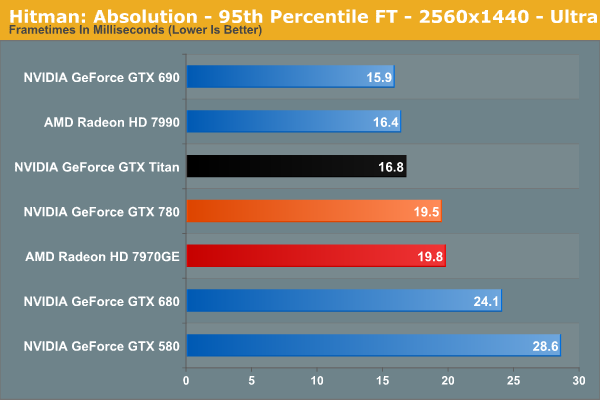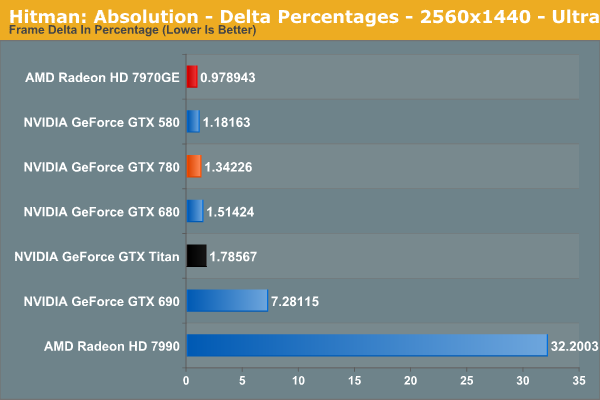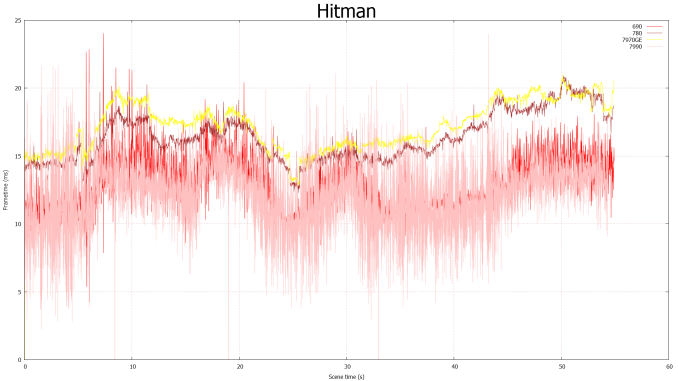NVIDIA GeForce GTX 780 Review: The New High End
by Ryan Smith on May 23, 2013 9:00 AM ESTOur First FCAT & The Test
First announced back at the end of March, FCAT has been something of a bewildering experience for us. NVIDIA has actually done a great job on the software, but between picky games, flaky DVI cables, and dead SSDs (we killed an Intel enterprise grade SSD 910 with FCAT) things have not gone quite to plan, pushing back our intended use of FCAT more than once. In any case, with most of the kinks worked out we’re ready to start integrating it into our major GPU reviews.
For the time being we’re putting FCAT on beta status, as we intend to try out a few different methods of presenting data to find something that’s meaningful, useful, and legible. To that end we’d love to get your feedback in our comments section so that we can further iterate on our presentation and data collection.
We’ve decided to go with two metrics for our first run with FCAT. The first metric is rather simple: 95th percentile frametimes. For years we’ve done minimum framerates (when practical), which are similar in concept, so this allows us to collect similar stats at the end of the rendering pipeline while hopefully avoiding some of the quirkiness that comes from looking at minimum framerates within games themselves. The 95th percentile frametime is quite simply the amount of time it takes to render the slowest 5% of frames. If a game or video card is introducing significant one-off stuttering by taking too long to render some frames, this will show us.

This is primarily meant to capture single-GPU issues, but in practice with AMD having fixed the bulk of their single-GPU issues months ago, we don’t actually expect much. None the less it’s a good way of showing that nothing interesting is happening in those situations.
Our second metric is primarily focused on multi-GPU setups, and is an attempt to quantize the wild frametime variations seen at times with multi-GPU setups, which show up as telltale zigzag lines in frametime graphs.
In this metric, which for the moment we’re calling Delta Percentages, we’re collecting the deltas (differences) between frametimes, averaging that out, and then running the delta average against the average frametime of the entire run. The end result of this process is that we can measure whether sequential frames are rendering in roughly the same amount of time, while controlling for performance differences by looking at the data relative to the average frametime (rather than as absolute time).

In general, a properly behaving single-GPU card should have a delta average of under 3%, with the specific value depending in part on how variable the workload is throughout any given game benchmark. 3% may sound small, but since we’re talking about an average it means it’s weighed against the entire run. The higher the percentage the more unevenly frames are arriving, and exceeding 3% is about where we expect players with good eyes to start noticing a difference. Alternatively in a perfectly frame metered situation, such as v-sync enabled with a setup that can always hit 60fps, then this would be a flat 0%, representing the pinnacle of smoothness.
Moving on, we’ll be running FCAT against 6 of our 10 games for the time being: Sleeping Dogs, Hitman: Absolution, Total War: Shogun 2, Battlefield 3, Bioshock, and Crysis 3. The rest of our games are either highly inconsistent or generally fussy, introducing too much variance into our FCAT results.
Finally, due to the amount of additional time it takes to put together FCAT results, we’re going to primarily publish FCAT results with major product launches and major driver updates. Due to how frame metering works, the only time frame consistency significantly changes is either with the introduction of new architectures/GPUs, or with the introduction of significant driver changes, so those are the scenarios we’ll be focusing on.
The Test
NVIDIA’s launch drivers for the GTX 780 are 320.18, drivers that are essentially identical to the public 320.14 drivers released last week.
| CPU: | Intel Core i7-3960X @ 4.3GHz |
| Motherboard: | EVGA X79 SLI |
| Power Supply: | Antec True Power Quattro 1200 |
| Hard Disk: | Samsung 470 (256GB) |
| Memory: | G.Skill Ripjaws DDR3-1867 4 x 4GB (8-10-9-26) |
| Case: | Thermaltake Spedo Advance |
| Monitor: | Samsung 305T |
| Video Cards: |
AMD Radeon HD 7970 GHz Edition AMD Radeon HD 7990 NVIDIA GeForce GTX 580 NVIDIA GeForce GTX 680 NVIDIA GeForce GTX 690 NVIDIA GeForce GTX 780 NVIDIA GeForce GTX Titan |
| Video Drivers: |
NVIDIA ForceWare 320.14 NVIDIA ForceWare 320.18 AMD Catalyst 13.5 Beta 2 |
| OS: | Windows 8 Pro |











155 Comments
View All Comments
lukarak - Friday, May 24, 2013 - link
1/3rd FP32 and 1/24th FP32 is nowhere near 10-15% apart. Gaming is not everything.chizow - Friday, May 24, 2013 - link
Yes fine cut gaming performance on 780 and Titan down to 1/24th and see how many of these you sell at $650 and $1000.Hrel - Friday, May 24, 2013 - link
THANK YOU!!!! WHY this kind of thing isn't IN the review is beyond me. As much good work as Nvidia is doing they're pricing schemes, naming schemes and general abuse of customers has turned me off of them forever. Which convenient because AMD is really getting their shit together quickly.chizow - Saturday, May 25, 2013 - link
Ryan has danced around this topic in the past, he's a pretty straight shooter overall but it goes without saying why he isn't harping on this in his review. He has to protect his (and AT's) relationship with Nvidia to keep the gravy train flowing. They have gotten in trouble with Nvidia in the past (sometime around the "not covering PhysX enough" fiasco, along with HardOCP) and as a result, their review allocation suffered.In the end, while it may be the truth, no one with a vested interest in these products and their future success contributing to their livelihoods wants to hear about it, I guess. It's just us, the consumers that suffer for it, so I do feel it's important to voice my opinion on the matter.
Ryan Smith - Sunday, May 26, 2013 - link
While you are welcome to your opinion and I doubt I'll be able to change it, I would note that I take a dim view towards such unfounded nonsense.We have a very clear stance with NVIDIA: we write what we believe. If we like a product we praise it, if we don't like a product we'll say so, and if we see an issue we'll bring it up. We are the press and our role is clear; we are not any company's friend or foe, but a 3rd party who stakes our name and reputation (and livelihood!) on providing unbiased and fair analysis of technologies and products. NVIDIA certainly doesn't get a say in any of this, and the only thing our relationship is built upon is their trusting our methods and conclusions. We certainly don't require NVIDIA's blessing to do what we do, and publishing the truth has and always will come first, vendor relationships be damned. So if I do or do not mention something in an article, it's not about "protecting the gravy train", but about what I, the reviewer, find important and worth mentioning.
On a side note, I would note that in the 4 years I have had this post, we have never had an issue with review allocation (and I've said some pretty harsh things about NVIDIA products at times). So I'm not sure where you're hearing otherwise.
chizow - Monday, May 27, 2013 - link
Hi Ryan I respect your take on it and as I've said already, you generally comment on and understand more about the impact of pricing and economy more than most other reviews, which is a big part of the reason I appreciate AT reviews over others.That being said, much of this type of commentary about pricing/economics can be viewed as editorializing, so while I'm not in any way saying companies influence your actual review results and conclusions, the choice NOT to speak about topics that may be considered out of bounds for a review does not fall under the scope of your reputation or independence as a reviewer.
If we're being honest here, we're all human and business is conducted between humans with varying degrees of interpersonal relationships. While you may consider yourself truthful and forthcoming always, the tendency to bite your tongue when friendships are at stake is only natural and human. Certainly, a "How's your family?" greeting is much warmer than a "Hey what's with all that crap you wrote about our GTX Titan pricing?" when you meet up at the latest trade show or press event. Similarly, it should be no surprise when Anand refers to various moves/hires at these companies as good/close friends, that he is going to protect those friendships where and when he can.
In any case, the bit I wrote about allocation was about the same time ExtremeTech got in trouble with Nvidia and felt they were blacklisted for not writing enough about PhysX. HardOCP got in similar trouble for blowing off entire portions of Nvidia's press stack and you similarly glossed over a bunch of the stuff Nvidia wanted you to cover. Subsequently, I do recall you did not have product on launch day and maybe later it was clarified there was some shipping mistake. Was a minor release, maybe one of the later Fermi parts. I may be mistaken, but pretty sure that was the case.
Razorbak86 - Monday, May 27, 2013 - link
Sounds like you've got an axe to grind, and a tin-foil hat for armor. ;)ambientblue - Thursday, August 8, 2013 - link
Well, you failed to note how the GTX 780 is essentially kepler's version of a GTX 570. It's priced twice as high though. The Titan should have been a GTX 680 last year... its only a prosumer card because of the price LOL. that's like saying the GTX 480 is a prosumer card!!!cityuser - Thursday, May 23, 2013 - link
whatever Nvidia do, it never improve their 2D quality, I mean , look at what nVidia will give you at BluRay playing, the color still dead , dull, not really enjoyable.It's terrible to use nVidia to HD home cinema, whatever setting you try.
Why nVidia can ignore this? because it's spoiled.
Dribble - Thursday, May 23, 2013 - link
What are you going on about?Bluray is digital, hdmi is digital - that means the signal is decoded and basically sent straight to the TV - there is no fiddling with colours, or sharpening or anything else required.